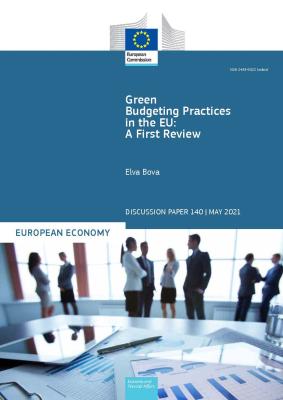What is Green Budgeting?
Green budgeting means using the tools of budgetary policymaking to help achieve climate and environmental goals.
Green budgeting is a process whereby the environmental contributions of budgetary items and policies are identified and assessed with respect to specific performance indicators, with the objective of better aligning budgetary policies with environmental goals.

Overview
Why is Green Budgeting important?
Greening national budgets is key for climate action and the green transition. This is because budgets are one of the main expressions of how a government intends to implement its political ambition. The 2019 European Commission’s Green Deal Communication highlights that “a greater use of green budgeting tools will help to redirect public investment, consumption and taxation to green priorities and away from harmful subsidies”
- 11 DECEMBER 2019
Tools
EU Green Budgeting Reference Framework (GBRF)
The European Commission, jointly with the EU Member States, has developed a EU Green Budgeting Reference Framework (GBRF) as a toolkit for Member States willing to implementing or upgrade green budgeting practices.
- 20 JANUARY 2022
European Commission Green Budgeting Survey
The European Commission launched a survey that aims to gather information on green budgeting practices in Member States and plans for future developments. Where green budgeting practices are in place, this survey aims to gain a better understanding of the design of these practices, their implementation and the remaining challenges.
Green and Brown budgetary items lists
To support Member States in developing their own green budgeting practices, DG ECFIN has produced two lists of budgetary items whose net environmental impact could be considered broadly as ‘green’ or ‘brown’. These lists are only indicative and not comprehensive, in that they provide some key examples of ‘mostly’ green and ‘mostly’ brown measures. They could serve as a starting point for those Member States that wish to develop their own green budget tagging methodology.
- 20 JANUARY 2022
- 20 JANUARY 2022
- 20 JANUARY 2022
Training
The European Commission has developed a technical support initiative to help Member States build administrative and technical capacity for developing a green budgeting framework at a national level. The training supports the alignment of the current or planned national green budgeting practices with the European Commission’s Green Budgeting Reference Framework. In 2021, 23 Member States joined this training. The training comprises three modules:
- Module 1 defines green budgeting and provides an overview of existing green budgeting frameworks and national practices. It also provides some basics on performance budgeting and green tagging.
- Module 2 consists of case studies tailored to the specific needs of each Member State. It provides an understanding of the main methods and challenges of identifying expenditure, tax expenditure and revenue that are relevant to climate and environmental objectives.
- Module 3 is a country-specific guided diagnostic/self-assessment of institutional settings and capacities, and concludes with recommendations on areas of improvement.
Supporting the Implementation of Green Budgeting Practices among the EU Member States
Publications

- Scientific paper
- Simona Pojar, Directorate-General for Economic and Financial Affairs
This paper presents how green budgeting is integrated into the regular budget process and influences decision making and budget allocation.

- Scientific paper
- Simona Pojar, Directorate-General for Economic and Financial Affairs
This paper presents an overview of environmental assessment practices across EU Member States, covering both ex-ante impact assessments and ex-post evaluations.

- Report
- Directorate-General for Economic and Financial Affairs
This paper presents common elements of green budgeting, main underlying principles. It reviews the different tools and provides examples from the EU Member States.

- Scientific paper
- Elva Bova, Directorate-General for Economic and Financial Affairs
This paper presents an overview of green budgeting practices in selected Member States.
- 26 MARCH 2024
- 26 MARCH 2024
- 26 MARCH 2024
- 26 MARCH 2024
Event - Green Budgeting in the EU: a coherent approach for improved policy making
- 27 JUNE 2023
- 26 JUNE 2023
- 26 JUNE 2023
- 26 JUNE 2023
- 26 JUNE 2023
- 26 JUNE 2023
- 26 JUNE 2023
- 26 JUNE 2023
Other relevant material
Green budgeting for the EU budget
Performance framework and methodological approach to expenditure tagging
Climate mainstreaming architecture in 2021-2027
Mainstreaming in the EU budget (overview)
Climate and Biodiversity mainstreaming in the EU budget
2020 European Commission – OECD joint survey on green budgeting
OECD work on green budgeting
Green Budget Tagging : Introductory Guidance & Principles | OECD iLibrary
Green Budgeting in OECD Countries | OECD iLibrary
Paris Collaborative on Green Budgeting - OECD
IMF work on green public finances
Climate-Sensitive Management of Public Finances—"Green PFM” (imf.org)
Strengthening Infrastructure Governance for Climate-Responsive Public Investment (imf.org)
